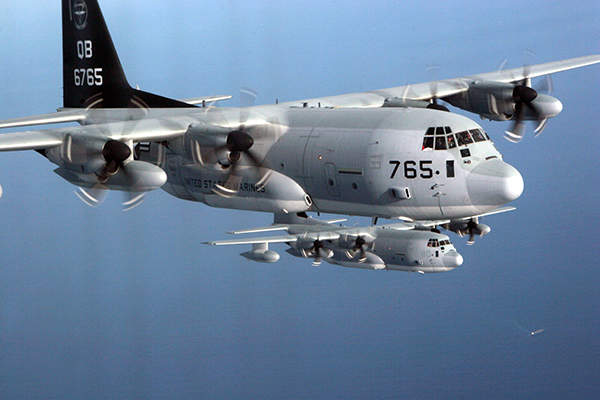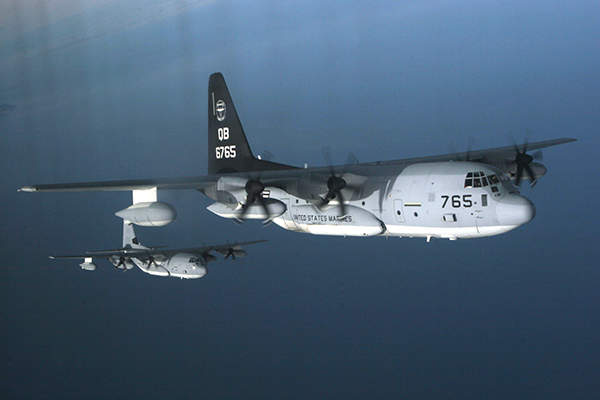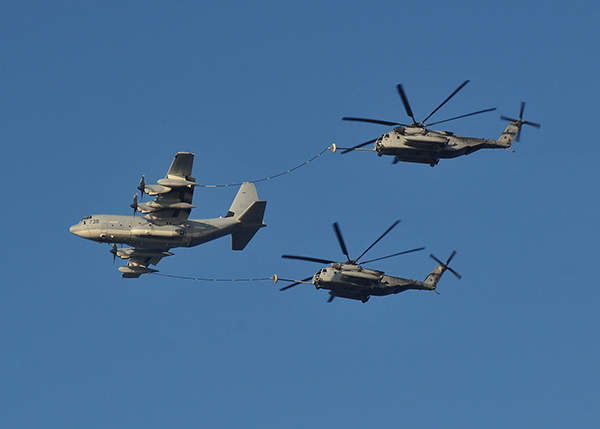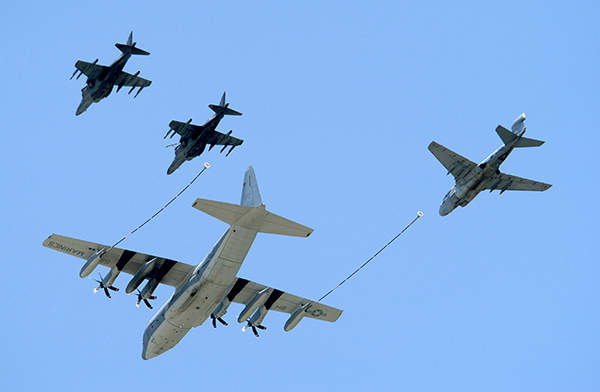The KC-130J is a multi-role, medium-sized fixed-wing aerial refuelling aircraft manufactured by Lockheed Martin primarily for the US Marine Corps (USMC). The USMC fleet of KC-130J accumulated more than 20,000 flight hours in Iraq.
The aircraft is used by operating forces for aerial refuelling, ground refuelling, tactical transportation of personnel or cargo, and logistic support missions.
The US Navy and USMC currently operate a fleet of 47 KC-130J Hercules aircraft. The total additional requirement of both these operators is 104.
KC-130J design features
The KC-130J is an advanced derivative of the base C-130J transport aircraft. It incorporates state-of-the-art technology and performance improvements in addition to the built-in features of the basic C-130J aircraft. The KC-130J also integrates a fire control unit for weapon systems.
The aircraft has a length of 29.3m, wing-span of 39.7m and height of 11.4m. It has a cargo volume of 4,551ft³. The maximum gross take-off weight of the aircraft is 79,380kg.
KC-130J mission capabilities
The KC-130J can be deployed in a wide range of missions, including troops and cargo transportation, aerial refuelling, aerial delivery, emergency resupply missions, and medical evacuation (MEDEVAC) from ungraded landing zones. The aircraft can also be used for the emergency evacuation of personnel and cargo, close air support (CAS), the illumination of combat areas, and multisensor-image-based reconnaissance.
The tanker aircraft carries 92 ground troops or 64 paratroopers and equipment in its tactical transport role. It can also be configured as a MEDEVAC aircraft accommodating 74 patients on stretchers, and their accompaniments.
The aircraft has a 57,500lb fuel offload capability and can perform missions in a radius of up to 500nmi. It can be optionally fitted with an additional fuselage tank for the storage of 24,392lb of fuel. It can unload up to 600gal of fuel per minute, which is about four times the current offload rate.
Cockpit
The aircraft is crewed by two pilots, one advanced crew station (ACS) operator and two loadmasters. The glass cockpit accommodates night-vision goggle head-up displays, multi-function displays, monochrome displays, ground collision avoidance system, global positioning system, and radio communications/navigation equipment.
Weapon systems
The KC-130J aircraft is armed with Harvest HAWK (Hercules Airborne Weapons Kit) modular roll-on, roll-off weapons system. The unit is housed within a standard cargo pallet placed in the cargo compartment. Target detection is provided by the AN/AAQ-30 target sight system mounted under the left-wing fuel tank. The unit is equipped with infrared and electro-optic sensors.
Its weapon system can fire Hellfire air-to-surface missiles (ASMs) and precision-guided munitions including Raytheon AGM-175 Griffin or MBDA GBU-44/B Viper Strike missiles. The Hellfire is mounted on the left-hand pylon, while the other missiles are launched from the cargo ramp.
In May 2012, US Naval Air Systems Command (NAVAIR) placed a contract with Lockheed Martin to deliver three Harvest HAWK systems for the KC-130J fleet.
Engines and performance of KC-130J
The KC-130J is powered by four Rolls-Royce AE 2100D3 turboprop engines. Each engine, driving an all-composite six-blade R391 propeller, develops a power of 3,425kW.
The propeller feathering capability of the aircraft will reduce the rotation speed of the propellers when pumping the fuel during ground refuelling. This avoids the prop wash behind the aircraft and allows the ground forces to perform ground-based refuelling missions in quiet environments.
The aircraft has a maximum range of 4,275nmi with external tanks. It can carry a maximum payload of 47,903lb, including maximum wing relieving fuel.
Orders and deliveries
In 2002, Lockheed Martin received a $4.3bn contract from the US Department of Defense to deliver 40 C-130J aircraft for the US Air Force and 20 KC-130J tankers for the USMC. The Marine Corps received the first KC-130J aircraft in November 2004. Lockheed Martin delivered the first KC-130J Super Hercules tanker to the US Marine Corps Reserve in March 2014.
The Italian Air Force (Aeronautica Militare Italiana) received six KC-130J tankers under a 22-aircraft programme, which concluded in 2005.
In May 2010, the US Government placed a $245m foreign military sales contract with Lockheed Martin for the delivery of three KC-130J aircraft to the Kuwait Air Force. The first aircraft was delivered in August 2014.
In November 2012, Saudi Arabia requested the sale of 20 C-130J-30 aircraft and five KC-130J aerial refuelling tankers. The first two KC-130J aerial refuellers were delivered in March 2016.







